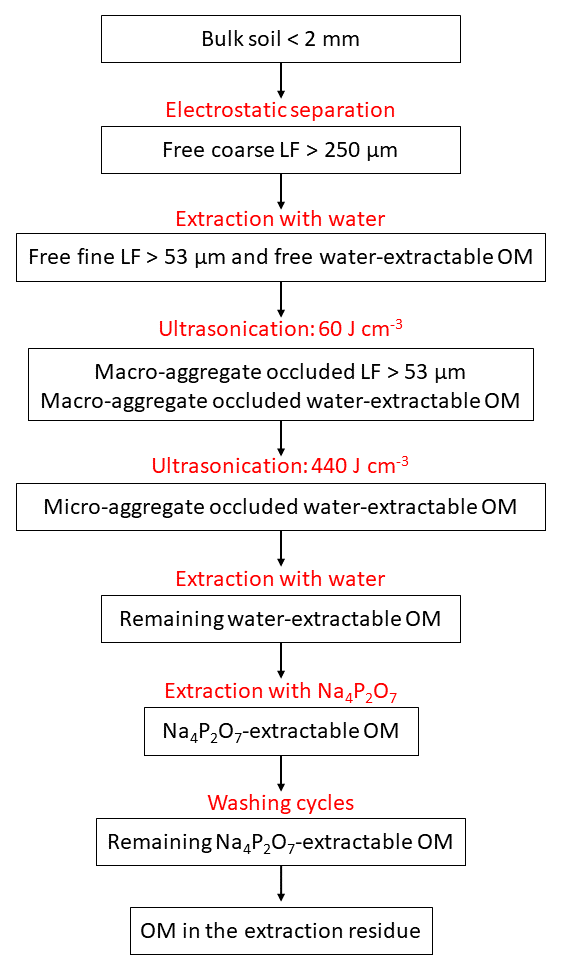Aggregates+Particles+Density+Extraction Kaiser
Description and working steps
Electrostatic separation: bulk soil <2 mm (10 g) was dry sieved using a 250 µm mesh sieve, coarse free (not aggregate occluded) LF was separated by electrostatic attraction according from the >250 µm fraction (modified; Kaiser et al., 2009, SSSAJ); thereafter, the POM free >250 µm fraction was recombined with the <250 µm fraction
Water extraction: the soil sample without coarse free LF (5 g) was mixed with 30 ml water and gently shaken by hand five times, the suspension was allowed to settle for 5 min., the supernatant was then pipetted over 53 µm mesh sieve to separate the floating fine free LF, the sieved supernatant was then recombined with the extraction residue, thereafter water was added up until a total of 50 ml is reached, the suspension was then shaken for 12 h, centrifuged (30 min, 4000 g) and the supernatant was decanted and filtered (0.45 µm) to separate the free water-extractable OM, the filtrate was freeze dried (Kaiser et al., 2010; SBB)
Ultrasonication: the extraction residue was mixed with 30 ml water and sonicated with 60 J cm-3 of to disperse macro-aggregates, thereafter the suspension was allowed to settle for 5 min. and the supernatant was pipetted over a 53 µm mesh sieve to separate the released, formerly macro-aggregate occluded LF, the sieved supernatant was added to the sample and the suspension was centrifuged and the supernatant was filtrated to separate the macro-aggregate occluded water-extractable OM, the filtrate was freeze dried; this procedure was repeated with an application of 440 J cm-3 ultrasonic energy to disperse micro-aggregates and to separate the occluded water-extractable OM; thereafter, the water extraction was repeated to separate the remaining water-extractable OM (Kaiser et al., 2010, SBB)
Na4P2O7 extraction and OM in the extraction residues: the extraction residue was mixed with 50 ml 0.1 M Na4P2O7-solution and shaken for six hours, the suspension was then centrifuged and the supernatant was filtrated, the extraction was repeated and both filtrates were combined, dialyzed (MWCO: 1000 Dalton) and freeze dried to separate the Na4P2O7 –extractable OM (bound via cation mediated interactions); thereafter, the extraction residue was mixed with 50 ml water, shaken by hand, centrifuged and the supernatant was decanted, this step was repeated five times, the decanted supernatants were combined, filtrated, dialyzed and freeze dried to separate the remaining Na4P2O7 –extractable OM, the cleaned extraction residue, containing the remaining OM (occluded in highly stable small micro-aggregates), was freeze dried (modified; Kaiser et al., 2016; Geoderma)
Soils: the method has been applied to a wide range of samples from mineral soils (0-40 cm depth) developed from different parent materials under forest and agricultural land use
Initial Aim
The method was developed under the following premises:
- to separate ecological meaningful soil organic matter (OM) fractions differing in the mean residence time and stabilized by specific mechanisms
- the targeted OM fractions were: i) free, macro-aggregate (>250 µm) occluded as well as micro-aggregate (250-53 µm) occluded organic particles as well as water extractable OM, ii) OM stabilized via cation mediated interactions (chelates, cross-linking, cation bridges) (Na4P2O7 soluble) and iii) OM occluded in highly stable micro-aggregates (<53 µm) (extraction residue)
- to avoid redistribution among and mixing of specific OM fractions of different soil ecological meaning as much as possible
Advantages
separation of OM fractions according to the degree of decomposition, location within the soil matrix, and stabilization mechanism
Disadvantages
high work load, need of devices such as the ultrasonication equipment, freeze drier and dialyze tubes
References
Kaiser, M., Zederer, D.P., Ellerbrock, R.H., Sommer, M., Ludwig, B., 2016. Effects of mineral characteristics on content, composition, and stability of organic matter fractions separated from seven forest topsoils of different pedogenesis. Geoderma 263, 1-7.
Kaiser, M., Wirth, S., Ellerbrock, R.H., Sommer, M., 2010. Microbial respiration activities related to sequentially separated, particulate and water-soluble organic matter fractions from arable and forest topsoils. Soil Biology and Biochemistry 42, 418-428.
Kaiser, M., Ellerbrock, R.H., Sommer, M., 2009. Separation of Coarse Organic Particles from Bulk Surface Soil Samples by Electrostatic Attraction. Soil Science Society of America Journal 73, 2118-2130.
